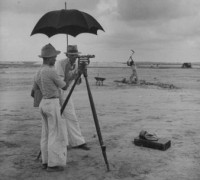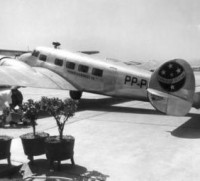AIRPORT DEVELOPMENT PROGRAM - A.D.P. AIRPORT DEVELOPMENT PROGRAM
1)A.D.P. AIRPORT DEVELOPMENT PROGRAM
When the Air Forces proposed in the fall of 1941 to arrange with Pan American for the construction of additional facilities in Brazil, the War Plans Division expressed opposition not only because of the reluctance of Brazil to cooperate more wholeheartedly in defense plans but also because "Pan American's performance under the contract has been so slow and of such a nature that additional construction at sites now included under the Pan American contract should be undertaken through Pan American only if no other solution is possible.
"When the Air Forces renewed its recommendation for an expansion of Latin American airport facilities after the United States entered the war, the G-4 Division urged that much closer supervision of the current Airport Development Program be carried out than had theretofore been customary and that "any new work not included in the original contract or its pending modification be undertaken by some means other than further modification of the existing contract with Pan American Airports Corporation.
"But after the transfer of supervisory control to the Chief of the Army Air Forces on 4 February 1942, the Chief of Engineers notified him "that it had been determined under existing diplomatic arrangements with South America that the only feasible method to prosecute this work was through Pan American."
After February 1942 the Army Engineers maintained much closer supervision over Pan American's contract work, and the Department of State in March 1942 facilitated supervision by formally notifying the governments concerned of the interest of the United States Government in the airport construction program.The expansion of the original Pan American contract began in May 1941 with a War Department authorization to Pan American to construct an airfield near Cayenne, French Guiana. Pan American wanted this field for commercial reasons and the Army wanted it because of the 440-mile gap between Zandery Field in Dutch Guiana and the first Brazilian field at Amapá--a gap notable for its bad flying weather.
Local French authorities, though loyal to Vichy, also wanted the airfield built, and for several months during 1941 they successfully cooperated with Pan American to conceal its identity as the constructor and prospective user of the Cayenne airfield. Nazi pressure through the Vichy Government finally led to the removal of the local French governor who had pushed the project, and work on the Cayenne airfield was suspended in August 1941. Primarily for political reasons, the Army agreed during 1941 to add a limited airport program for Paraguay and Bolivia to the Pan American contract.
The War Plans Division consistently opposed any military airfield program for southern South America as being unnecessary under current war plans or under any likely development of the strategic situation. Nevertheless, the Chief of Staff yielded to Department of State requests that this work be undertaken, partly because the Air Corps favored it and partly because he himself believed that airfield development in Paraguay and Bolivia was preferable to the alternative of supplying them with Army munitions.
In May President Roosevelt approved the expenditure of an additional $2,000,000 of emergency funds for airfields in Paraguay and Bolivia, and two months later G-4 was authorized to contract with Pan American for work on two fields in each country. A Department of State proposal that the Army lend similar backing to an airport development scheme in Uruguay met with a different response.
Current military plans and the existing war situation did not envisage any possible Army air operations as far south as Uruguay. Although the Air Forces looked upon the Uruguayan project with some favor, the General Staff successfully opposed an extension of the Pan American contract to include it, and the staff also opposed the expenditure of War Department lend-lease funds to do the work by other means.The basic Pan American contract of 2 November 1940 was revised a year later to include the Paraguayan and Bolivian airfield work and to provide additional funds for speeding construction at the sites originally chosen, for new facilities at these airfields, and for other purposes.
This revision increased the allotment of emergency funds for the Airport Development Program before Pearl Harbor from $12,000,000 to $19,000,000. Soon after the United States entered the war, the Army Air Forces proposed a further expansion of the airfield program, primarily to increase the capacity of the South Atlantic airway via Brazil. For some weeks the War Plans Division and General Headquarters opposed any major expansion of Brazilian airfield facilities unless assurances were obtained that this airway could be properly defended.
The improvement in the war outlook and in Brazilian-American relations overcame these objections, and the Air Forces after assuming supervisory control over the airfield program in February 1942 proceeded to expand it in Brazil and elsewhere. By the end of June 1942 a total of about $33,000,000 had been allotted to Pan American contract work on airfields in Latin America.
Thereafter during the wartime years the United States Army continued to depend primarily on Pan American Airways for the development and maintenance of airfields in the Latin American nations in which the airline had undertaken construction work for military purposes before Pearl Harbor. By midsummer of 1944, when the airfield construction program was virtually complete, Pan American had built new airfields or improved existing facilities at forty different locations, including the development of sixteen landplane and five seaplane bases in Brazil and of eight landplane bases in Mexico.
The construction costs of airfields included in the Airport Development Program amounted eventually to more than $90,000,000, and by the summer of 1945 the Army had also paid Pan American more than $10,000,000 for maintenance of the airfields. Considerably more than half of this money was expended on airfield construction and maintenance work in Brazil, primarily to provide facilities for the tremendous volume of air traffic that flowed to and from the fighting fronts of the Old World.
Source: Hyper War Foundation by Patrick Clancey.

